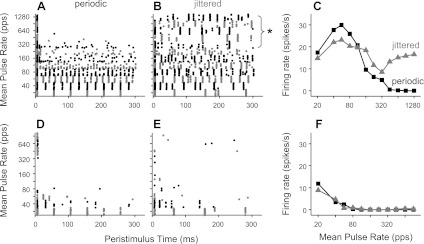Fig. 2.
Single-unit examples show variable sensitivity to pulse train jitter. Top: jitter-sensitive neuron. Bottom: jitter-insensitive neuron. Dot rasters show temporal firing patterns in response to periodic (A and D) and jittered (B and E) pulse trains. Alternating colors distinguish blocks of trials at different pulse rates. C and F: corresponding rate-vs.-pulse rate curves. Jitter restored ongoing firing to high pulse rates for the neuron at the top but not at the bottom. Responses to repeated presentations of high-rate jittered stimuli were characterized by sparse, preferred firing times (* in B). pps, pulses/s.

